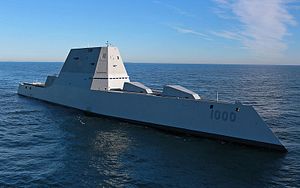The USS Zumwalt, the U.S. Navy’s largest and most expensive guided missile destroyer built to date, has departed the General Dynamics Bath Iron Works shipyard in Maine for final builder trials in the Atlantic Ocean, USNI News reports.
Construction of the 16,000-ton Zumwalt began in 2008 yet suffered from repeated delays. The USS Zumwalt is slated to be handed over to the U.S. Navy for inspection next month and will be commissioned this October. The first-in-class guided missile destroyer already conducted sea-tests and trials in the Atlantic Ocean in December 2015.
According to a U.S. Navy statement published by USNI News, the current trials will involve many of the Zumwalt’s key systems and technologies, and include demonstrations “on the Advanced Induction Motor (AIM), Integrated Propulsion System (IPS), Boat Handling, and auxiliary systems.”
The statement added that “the Navy-industry team will be conducting numerous operational demonstrations in preparation for Acceptance Trials in April, as well as crew familiarization and counterpart training in support of crew certification, sail away milestones, and commissioning October 15, 2016.”
Once the current trials and tests are completed, the U.S. Navy will conduct rough-weather trials to assess the seaworthiness of the ship. “We go to find the most miserable places in the ocean and drive at various sea stages,” Rear Admiral Peter Fanta, the U.S. Navy’s director of surface warfare, told the Associated Press. This will be one of the crucial tests for the new vessel. Naval experts have repeatedly raised concerns over the ship’s so-called tumblehome hull and how it will impact the ship’s ability to stay afloat during bad weather periods.
Nevertheless, the U.S. Navy continues to defend the design feature, noting that the “tumblehome ship design has provided a wide array of advancements.” Among those benefits, the Navy argues, “The composite superstructure significantly reduces cross section and acoustic output making the ship harder to detect by enemies at sea. The design also allows for optimal manning with a standard crew size of 175 sailors, with an air detachment of 28 thereby decreasing lifecycle operations and support costs.”
However, next to the large price tag of the new vessel (the lead ship is estimated to cost more than $4.4 billion), it was allegedly the concern over the Zumwalt’s seaworthiness that made the U.S. Navy cut down its order from 32 to three (some sources two) new guided missile destroyers.
Once operational, the new destroyer will be one of the most heavily armed surface naval weapons platforms of the U.S. Navy, capable of striking its targets from a long distance. “Each ship features a battery of two Advanced Gun Systems (AGS) firing Long-Range Land Attack Projectiles (LRLAP) that reach up to 63 nautical miles [72 miles, 115 kilometers], providing a three-fold range improvement in naval surface fires coverage,” according to the U.S. Navy website.
The U.S. Navy is also thinking of arming the Zumwalt with new energy weapons including an electromagnetic railgun. The ship can produce up to 78 megawatts of energy and features a special Integrated Power System (IPS).
































